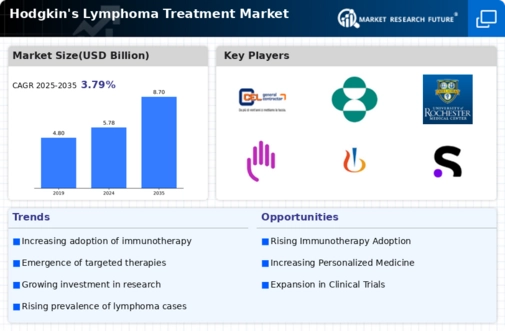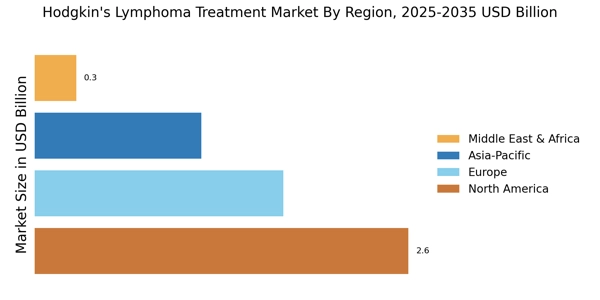Advancements in Treatment Modalities
Technological advancements in treatment modalities are significantly influencing the Hodgkin's Lymphoma Treatment Market. Innovations in chemotherapy regimens, radiation techniques, and the introduction of novel therapies such as CAR T-cell therapy have transformed the treatment landscape. For instance, the development of less toxic chemotherapy agents has improved patient tolerability and outcomes. Furthermore, the integration of precision medicine, which tailors treatment based on individual genetic profiles, is gaining traction. This shift towards more effective and personalized treatment options is expected to enhance patient survival rates and quality of life. Market data suggests that the introduction of these advanced therapies could lead to a substantial increase in market revenue, as healthcare providers seek to adopt the latest innovations to improve treatment efficacy. Thus, advancements in treatment modalities are likely to remain a key driver in the Hodgkin's Lymphoma Treatment Market.
Rising Incidence of Hodgkin's Lymphoma
The increasing incidence of Hodgkin's lymphoma is a pivotal driver for the Hodgkin's Lymphoma Treatment Market. Recent statistics indicate that the annual incidence rate of Hodgkin's lymphoma has been on the rise, particularly among young adults aged 15 to 39. This trend necessitates the development and availability of effective treatment options, thereby propelling market growth. As more individuals are diagnosed, healthcare systems are compelled to allocate resources towards innovative therapies and clinical trials. The heightened awareness surrounding this disease also contributes to early detection and treatment, which is crucial for improving patient outcomes. Consequently, the rising incidence of Hodgkin's lymphoma is likely to stimulate demand for various treatment modalities, including chemotherapy, radiation therapy, and emerging targeted therapies, thereby shaping the landscape of the Hodgkin's Lymphoma Treatment Market.
Growing Investment in Oncology Research
The growing investment in oncology research is a crucial driver for the Hodgkin's Lymphoma Treatment Market. Pharmaceutical companies and research institutions are increasingly allocating funds towards the development of new therapies and clinical trials aimed at Hodgkin's lymphoma. This surge in investment is driven by the potential for high returns on innovative treatments, particularly in the realm of immunotherapy and targeted therapies. Recent data indicates that the oncology sector has seen a significant increase in funding, with billions of dollars directed towards research initiatives. This financial commitment not only accelerates the pace of drug development but also fosters collaboration between academia and industry, leading to breakthroughs in treatment options. As a result, the growing investment in oncology research is expected to enhance the availability of effective therapies, thereby propelling the Hodgkin's Lymphoma Treatment Market forward.
Increased Awareness and Screening Programs
Increased awareness and screening programs for Hodgkin's lymphoma are vital drivers of the Hodgkin's Lymphoma Treatment Market. Public health campaigns and educational initiatives have significantly improved knowledge about the disease, leading to earlier diagnosis and treatment. Enhanced screening programs facilitate the identification of at-risk populations, which is crucial for timely intervention. As awareness grows, more individuals are likely to seek medical attention for symptoms associated with Hodgkin's lymphoma, resulting in higher diagnosis rates. This trend is further supported by healthcare policies that promote regular screenings and check-ups. Consequently, the increase in awareness and screening programs is expected to drive demand for treatment options, as more patients are diagnosed and require effective therapies. This dynamic is likely to have a lasting impact on the Hodgkin's Lymphoma Treatment Market.
Regulatory Support for Innovative Therapies
Regulatory support for innovative therapies is an essential driver of the Hodgkin's Lymphoma Treatment Market. Regulatory agencies are increasingly expediting the approval processes for new treatments, particularly those that demonstrate significant therapeutic advancements. This trend is evident in the approval of breakthrough therapies and orphan drugs, which aim to address unmet medical needs in Hodgkin's lymphoma. The favorable regulatory environment encourages pharmaceutical companies to invest in research and development, knowing that their innovative solutions may receive faster market access. Additionally, initiatives such as priority review and accelerated approval pathways are designed to bring effective treatments to patients more swiftly. As a result, regulatory support is likely to enhance the availability of novel therapies, thereby stimulating growth in the Hodgkin's Lymphoma Treatment Market.


















Leave a Comment